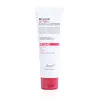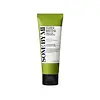What's inside
What's inside
 Key Ingredients
Key Ingredients

 Benefits
Benefits

 Concerns
Concerns

 Ingredients Side-by-side
Ingredients Side-by-side

Water
Skin ConditioningSodium Cocoyl Alaninate
Glycerin
HumectantDipropylene Glycol
HumectantCoco-Glucoside
CleansingDisodium Cocoamphodiacetate
CleansingPotassium Cocoate
EmulsifyingAcrylates/C10-30 Alkyl Acrylate Crosspolymer
Emulsion Stabilising1,2-Hexanediol
Skin ConditioningSalicylic Acid
MaskingPolyglyceryl-10 Laurate
Skin ConditioningButylene Glycol
HumectantCitric Acid
BufferingUlmus Davidiana Root Extract
Skin ConditioningHouttuynia Cordata Extract
Skin ConditioningPinus Palustris Leaf Extract
TonicOenothera Biennis Flower Extract
AstringentPueraria Lobata Root Extract
HumectantLactococcus Ferment Lysate
Skin ConditioningSaccharomyces Ferment
Skin ConditioningSodium Hyaluronate
HumectantHydrolyzed Hyaluronic Acid
HumectantSodium Acetylated Hyaluronate
HumectantAllantoin
Skin ConditioningCapryloyl Salicylic Acid
ExfoliatingDipotassium Glycyrrhizate
HumectantCentella Asiatica Extract
CleansingCentella Asiatica Root Extract
Skin ConditioningCentella Asiatica Leaf Extract
Skin ConditioningAsiaticoside
AntioxidantMadecassoside
AntioxidantMadecassic Acid
Skin ConditioningAsiatic Acid
Skin ConditioningLactobionic Acid
BufferingEthylhexylglycerin
Skin ConditioningHydroxyacetophenone
AntioxidantRosmarinus Officinalis Leaf Oil
MaskingMelaleuca Alternifolia Leaf Oil
AntioxidantTromethamine
BufferingSodium Chloride
MaskingPhenylpropanol
MaskingSodium Levulinate
Skin ConditioningLevulinic Acid
PerfumingWater, Sodium Cocoyl Alaninate, Glycerin, Dipropylene Glycol, Coco-Glucoside, Disodium Cocoamphodiacetate, Potassium Cocoate, Acrylates/C10-30 Alkyl Acrylate Crosspolymer, 1,2-Hexanediol, Salicylic Acid, Polyglyceryl-10 Laurate, Butylene Glycol, Citric Acid, Ulmus Davidiana Root Extract, Houttuynia Cordata Extract, Pinus Palustris Leaf Extract, Oenothera Biennis Flower Extract, Pueraria Lobata Root Extract, Lactococcus Ferment Lysate, Saccharomyces Ferment, Sodium Hyaluronate, Hydrolyzed Hyaluronic Acid, Sodium Acetylated Hyaluronate, Allantoin, Capryloyl Salicylic Acid, Dipotassium Glycyrrhizate, Centella Asiatica Extract, Centella Asiatica Root Extract, Centella Asiatica Leaf Extract, Asiaticoside, Madecassoside, Madecassic Acid, Asiatic Acid, Lactobionic Acid, Ethylhexylglycerin, Hydroxyacetophenone, Rosmarinus Officinalis Leaf Oil, Melaleuca Alternifolia Leaf Oil, Tromethamine, Sodium Chloride, Phenylpropanol, Sodium Levulinate, Levulinic Acid
Camellia Sinensis Leaf Water 62%
MaskingGlycerin
HumectantWater
Skin ConditioningPotassium Cocoyl Glycinate
Lauryl Glucoside
CleansingCoco-Glucoside
CleansingAcrylates Copolymer
Sodium Cocoyl Isethionate
Cleansing1,2-Hexanediol
Skin ConditioningSalix Alba Bark Water
AstringentSalix Alba Bark Extract
AstringentCentella Asiatica Extract
CleansingCentella Asiatica Leaf Extract
Skin ConditioningMelia Azadirachta Leaf Extract
Skin ConditioningMelia Azadirachta Flower Extract
Skin ConditioningCalamine
AbsorbentCamellia Sinensis Leaf Powder
ExfoliatingMelaleuca Alternifolia Leaf Powder
AbrasiveButylene Glycol
HumectantSodium Hyaluronate
HumectantAllantoin
Skin ConditioningMadecassic Acid
Skin ConditioningAsiaticoside
AntioxidantAsiatic Acid
Skin ConditioningMadecassoside
AntioxidantCocos Nucifera Oil
MaskingCoco-Caprylate/Caprate
EmollientCaprylyl Glycol
EmollientGlyceryl Undecylenate
EmollientPolyglyceryl-10 Myristate
Skin ConditioningPotassium Cetyl Phosphate
EmulsifyingLauric Acid
CleansingMannan
Lactobionic Acid
BufferingCitric Acid
BufferingTriethoxycaprylylsilane
Methylpropanediol
SolventBenzyl Glycol
SolventEthylhexylglycerin
Skin ConditioningRaspberry Ketone
MaskingParfum
MaskingCamellia Sinensis Leaf Water 62%, Glycerin, Water, Potassium Cocoyl Glycinate, Lauryl Glucoside, Coco-Glucoside, Acrylates Copolymer, Sodium Cocoyl Isethionate, 1,2-Hexanediol, Salix Alba Bark Water, Salix Alba Bark Extract, Centella Asiatica Extract, Centella Asiatica Leaf Extract, Melia Azadirachta Leaf Extract, Melia Azadirachta Flower Extract, Calamine, Camellia Sinensis Leaf Powder, Melaleuca Alternifolia Leaf Powder, Butylene Glycol, Sodium Hyaluronate, Allantoin, Madecassic Acid, Asiaticoside, Asiatic Acid, Madecassoside, Cocos Nucifera Oil, Coco-Caprylate/Caprate, Caprylyl Glycol, Glyceryl Undecylenate, Polyglyceryl-10 Myristate, Potassium Cetyl Phosphate, Lauric Acid, Mannan, Lactobionic Acid, Citric Acid, Triethoxycaprylylsilane, Methylpropanediol, Benzyl Glycol, Ethylhexylglycerin, Raspberry Ketone, Parfum
Ingredients Explained
These ingredients are found in both products.
Ingredients higher up in an ingredient list are typically present in a larger amount.
1,2-Hexanediol is a synthetic liquid and another multi-functional powerhouse.
It is a:
- Humectant, drawing moisture into the skin
- Emollient, helping to soften skin
- Solvent, dispersing and stabilizing formulas
- Preservative booster, enhancing the antimicrobial activity of other preservatives
Allantoin is a soothing ingredient known for its protective and moisturizingg properties. Because of this, it is often added to products with strong active ingredients.
Studies show higher concentrations of this ingredient can promote wound healing.
Though it can be derived from the comfrey plant, allantoin is produced synthetically for cosmetic products to ensure purity.
Learn more about AllantoinAsiatic Acid is a major component of Centella Asiatica Extract. It has wound-healing, anti-inflammatory, and antioxidant properties.
Studies show Asiatic Acid is able to block the pathway for skin inflammation receptors, helping to soothe skin.
As an antioxidant, asiatic acid helps protect our skin against damaging environmental factors.
Learn more about Asiatic AcidAsiaticoside comes from the super popular skin-soothing ingredient, Centella asiatica. It is one of four active compounds found in the extract of Centella Asiatica.
Asiaticoside is an antioxidant and helps with wound healing. It has been shown to increase antioxidant activity during the wound healing process.
Butylene Glycol (or BG) is used within cosmetic products for a few different reasons:
Overall, Butylene Glycol is a safe and well-rounded ingredient that works well with other ingredients.
Though this ingredient works well with most skin types, some people with sensitive skin may experience a reaction such as allergic rashes, closed comedones, or itchiness.
Learn more about Butylene GlycolCentella Asiatica Extract (Centella) is derived from an herb native to Southeast Asia. It is famous for its anti-inflammatory and soothing properties.
Centella is rich in antioxidants and amino acids, such as Madecassic Acid and Asiaticoside.
Studies show the compounds in centella help with:
The combination of all these properties makes centella effective at soothing, hydrating, and protecting the skin.
Other great components of centella include Vitamin A, vitamin C, several B vitamins, and Asiatic Acid.
Fun fact: Centella has been used as a medicine and in food for many centuries. As a medicine, it is used to treat burns, scratches, and wounds.
Learn more about Centella Asiatica ExtractCentella Asiatica Leaf Extract comes from the leaves of an herb plant native to Southeast Asia. Centella Asiatica is rich in antioxidants and amino acids. It can help reduce irritation and soothe the skin.
Many active components found in centella asiatica, such as Madecassic Acid and Asiaticoside, encourage the skin to naturally produce hyaluronic acid. This helps keep our skin hydrated. Many of these components also show antioxidant activity and may help reduce the signs of aging.
Research shows centella asiatica can help increase Type I collagen production by increasing fibroblast production. Fibroblast helps form connective tissue.
The combination of all these properties makes centella asiatica leaf extract effective at soothing the skin.
Other components of centella asiatica leaf extract include Vitamin A, vitamin C, several B vitamins, and Asiatic Acid.
Recent studies found madecassoside may help prevent damage from UV rays by preventing UV-induced inflammation. Further research is needed.
This plant has been used as a medicine and in food for many centuries. As a medicine, it is used to treat burns, scratches, and wounds.
Learn more about Centella Asiatica Leaf ExtractCitric Acid is an alpha hydroxy acid (AHA) naturally found in citrus fruits like oranges, lemons, and limes.
Like other AHAs, citric acid can exfoliate skin by breaking down the bonds that hold dead skin cells together. This helps reveal smoother and brighter skin underneath.
However, this exfoliating effect only happens at high concentrations (20%) which can be hard to find in cosmetic products.
Due to this, citric acid is usually included in small amounts as a pH adjuster. This helps keep products slightly more acidic and compatible with skin's natural pH.
In skincare formulas, citric acid can:
While it can provide some skin benefits, research shows lactic acid and glycolic acid are generally more effective and less irritating exfoliants.
Most citric acid used in skincare today is made by fermenting sugars (usually from molasses). This synthetic version is identical to the natural citrus form but easier to stabilize and use in formulations.
Read more about some other popular AHA's here:
Learn more about Citric AcidCoco-Glucoside is a surfactant, or a cleansing ingredient. It is made from glucose and coconut oil.
Surfactants help gather dirt, oil, and other pollutants from your skin to be rinsed away.
This ingredient is considered gentle and non-comedogenic. However, it may still be irritating for some.
Learn more about Coco-GlucosideEthylhexylglycerin (we can't pronounce this either) is commonly used as a preservative and skin softener. It is derived from glyceryl.
You might see Ethylhexylglycerin often paired with other preservatives such as phenoxyethanol. Ethylhexylglycerin has been found to increase the effectiveness of these other preservatives.
Glycerin is already naturally found in your skin. It helps moisturize and protect your skin.
A study from 2016 found glycerin to be more effective as a humectant than AHAs and hyaluronic acid.
As a humectant, it helps the skin stay hydrated by pulling moisture to your skin. The low molecular weight of glycerin allows it to pull moisture into the deeper layers of your skin.
Hydrated skin improves your skin barrier; Your skin barrier helps protect against irritants and bacteria.
Glycerin has also been found to have antimicrobial and antiviral properties. Due to these properties, glycerin is often used in wound and burn treatments.
In cosmetics, glycerin is usually derived from plants such as soybean or palm. However, it can also be sourced from animals, such as tallow or animal fat.
This ingredient is organic, colorless, odorless, and non-toxic.
Glycerin is the name for this ingredient in American English. British English uses Glycerol/Glycerine.
Learn more about GlycerinLactobionic Acid is a PHA. PHAs are the gentle cousins to AHAS.
Like AHAs, they exfoliate the top layer of skin. Lactobionic acid also exhibits significant antioxidant activity.
PHAs are more gentle than AHAs due to their larger structure. This means they do not penetrate as deeply as AHAs and take a longer time to dissolve dead cells. Studies show PHAs do not cause as much irritation.
By removing dead skin cells, PHAs leave the skin brighter and with even-texture.
Learn more about Lactobionic AcidMadecassic Acid is a major component of Centella Asiatica Extract. It has anti-inflammatory and antioxidant properties.
It is a triterpenoid, meaning it naturally acts as an antioxidant. Antioxidants protect your skin against damage from environmental factors such as pollution and UV.
Studies show Madecassic Acid helps soothe the skin due to its ability to block inflammation pathways.
Learn more about Madecassic AcidMadecassoside comes from the super popular skin-soothing ingredient, Centella asiatica. It is one of four active compounds found in the extract of Centella Asiatica.
Madecassoside has antioxidant, anti-inflammatory, and hydrating properties. It contains fatty acids, amino acids, beta-carotene, and phytochemicals.
One study found using Madecassoside with ascorbic acid helped reduce the signs of aging and improved skin hydration.
Learn more about MadecassosideSodium Hyaluronate is hyaluronic acid's salt form. It is commonly derived from the sodium salt of hyaluronic acid.
Like hyaluronic acid, it is great at holding water and acts as a humectant. This makes it a great skin hydrating ingredient.
Sodium Hyaluronate is naturally occurring in our bodies and is mostly found in eye fluid and joints.
These are some other common types of Hyaluronic Acid:
Learn more about Sodium HyaluronateWater. It's the most common cosmetic ingredient of all. You'll usually see it at the top of ingredient lists, meaning that it makes up the largest part of the product.
So why is it so popular? Water most often acts as a solvent - this means that it helps dissolve other ingredients into the formulation.
You'll also recognize water as that liquid we all need to stay alive. If you see this, drink a glass of water. Stay hydrated!
Learn more about Water